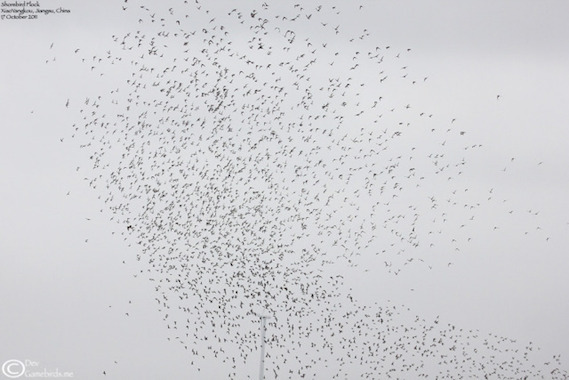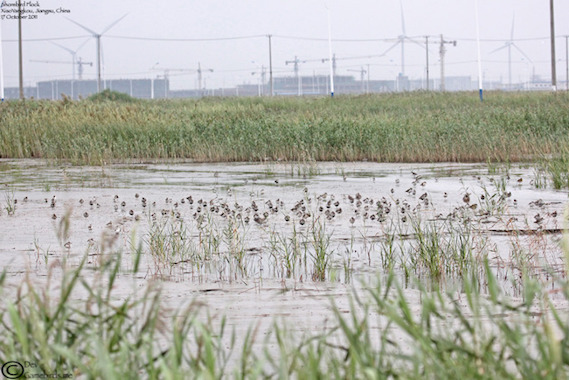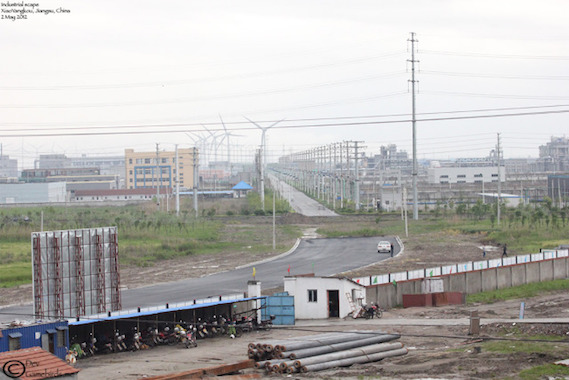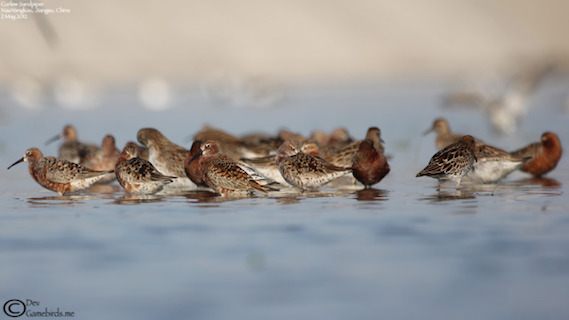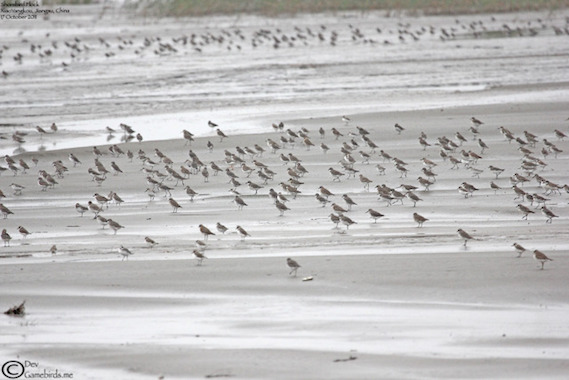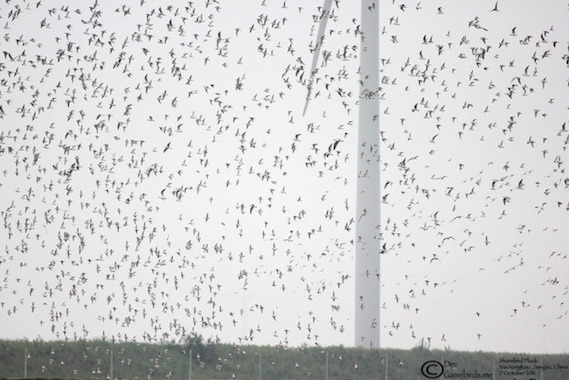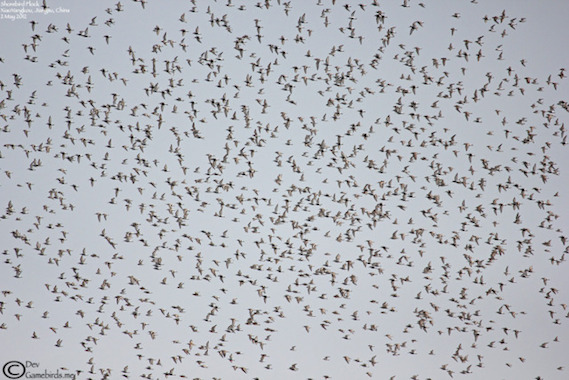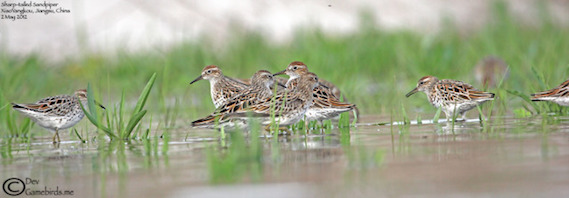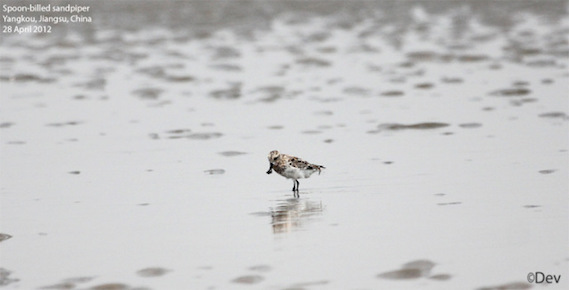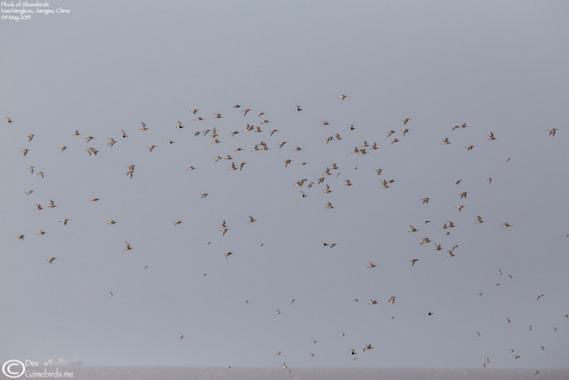by Devaram T
Yangkou also known as XiaoYangkou, the very famous coastal town for the Spoon-billed Sandpipers came into the light only in 2008. When Spoonies were found in good numbers since 2008, numerous birders and photographers came from every corner of the world to see this “Holy Grail.” Even before 2008, the mudflats were reclaimed for the windmills. I first visited the town in October 2011 and was awestruck by the shorebirds congregation. The birds were everywhere, especially during the high tide, the congregation is simply awesome. The shorebirds fly like the “Rosy Starling” flock. Yangkou is about 4 hours drive from Shanghai and I visited this town year after year and the town went through enormous changes every year.
Majority of the mudflats were reclaimed and windmills were installed and still more windmills were being installed and more turbines and blades are waiting to be installed. The windmills can be seen all the way to the horizon, not sure where this will lead to. Beware U.S, by 2020, first batch of Chinese windmills will be seen from Hawaii. All birders know windmills by their famous name “Bird Killers,” imagine thousands and thousands of windmills stacked on the mudflats? Since 2013, I didn’t witness the mass congregation of shorebirds in Yangkou, the disappearing mudflats and the industrialization of this small town. The windmills took over the mudflats and what’s left for the birds were the high tide roosting areas which were then reclaimed for the “Chemical Industrial Park.” As of 2015, the Chemical Industry park is fully functional emitting all sort of odours. When I first visited Yangkou in 2011, my colleagues told me that the town is famous for fresh sea food and frankly, one can smell the fresh catch of fishes when the fishing vessels enter the port. Now, the town reek’s of Chemical odour, even from miles away.
Despite all these environmental inflictions, Spoon-billed Sandpipers still love this place and Yangkou remains to be their main stopover site. Spoon-billed Sandpipers stay in Yangkou almost 6-7 months every year. Failed breeders and immature birds arrive by the last week of July and stay here till mid to last week of October. During Spring, they arrive by Mid March and stay till Mid May. It’s so sad to see their lovely home is eaten bit by bit.
In few years, there won’t be any mud flats left in Yangkou and so the eco-tourism. This year, there were tourism promotion banners around the temple site portraying the shorebirds and foreign bird watchers and photographers photographing the birds. Well, who will visit this town if there is no birds to see? Isn’t that bit late for promoting eco tourism in this town while the chemical industrial park is emitting all these hazardous exhausts in the air and waste water around the mudflats? Also, the sea wall to the east of the temple has been closed for more than a month for unknown reason, so the high-tide roosting dike cannot be reached. The situation of this place is unknown. I took the detour through the Chemical Industrial park to reach the mudflats and the park has a toll gate (not yet operational). One time, the guards stopped me to ask which company I’m visiting and what’s the purpose of my visit. When I told them, I’m here to watch birds and the sea wall was closed, they let me pass through. I was so surprised, how much the town had been aware of the birds. Most of the times, when you tell the guards that you are here watch birds, their first question will be is there any birds here? That leaves a huge dent in the ecotourism of Yangkou. People have just started to realize the potential of their small town and the shorebird’s favourite site has been wiped out from the face of the earth.
A look back at the glorious days of Yangkou.
The above image of the Spoonie is from April 2012 and this year there is a “Yurt” in this place. I said it right, there is now a “Yurt” in the place where Spoonie was seen two years before.
The drier inland areas are now being converted into fishing farms, that makes the situation complicated for the summer breeders like Common and Little Terns, Saunders’s Gull, Eurasian Oystercatcher, Grey-headed Lapwing, Oriental Prantincole, Little Ringed and Kentish Plovers.
While every man has to rest in peace, the greedy thoughts of becoming a superpower has put the well being of shorebirds to a huge risk. With less and less birds been stopping at Yangkou, may be in next two years, there won’t be any single shorebird at all in Yangkou.
Rest in peace, Yangkou.

